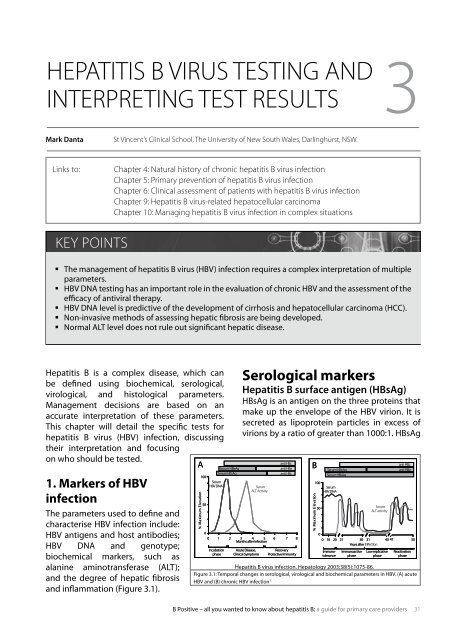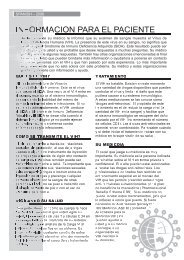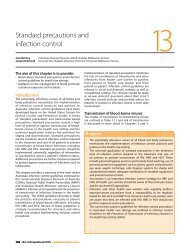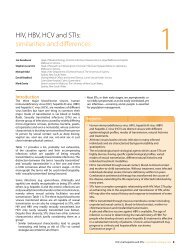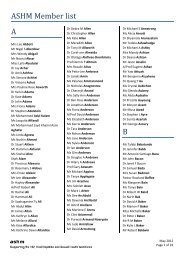B Positive – all you wanted to know about - ASHM
B Positive – all you wanted to know about - ASHM
B Positive – all you wanted to know about - ASHM
You also want an ePaper? Increase the reach of your titles
YUMPU automatically turns print PDFs into web optimized ePapers that Google loves.
HEPATITIS B VIRUS TESTING AND<br />
3<br />
INTERPRETING TEST RESULTS<br />
Mark Danta St Vincent’s Clinical School, The University of New South Wales, Darlinghurst, NSW.<br />
Links <strong>to</strong>: Chapter 4: Natural his<strong>to</strong>ry of chronic hepatitis B virus infection<br />
Chapter 5: Primary prevention of hepatitis B virus infection<br />
Chapter 6: Clinical assessment of patients with hepatitis B virus infection<br />
Chapter 9: Hepatitis B virus-related hepa<strong>to</strong>cellular carcinoma<br />
Chapter 10: Managing hepatitis B virus infection in complex situations<br />
KEY POINTS<br />
� the management of hepatitis b virus (HbV) infection requires a complex interpretation of multiple<br />
parameters.<br />
� HbV dna testing has an important role in the evaluation of chronic HbV and the assessment of the<br />
efficacy of antiviral therapy.<br />
� HbV dna level is predictive of the development of cirrhosis and hepa<strong>to</strong>cellular carcinoma (Hcc).<br />
� non-invasive methods of assessing hepatic fibrosis are being developed.<br />
� normal aLt level does not rule out significant hepatic disease.<br />
Hepatitis b is a complex disease, which can<br />
be defined using biochemical, serological,<br />
virological, and his<strong>to</strong>logical parameters.<br />
Management decisions are based on an<br />
accurate interpretation of these parameters.<br />
this chapter will detail the specific tests for<br />
hepatitis b virus (HbV) infection, discussing<br />
their interpretation and focusing<br />
on who should be tested.<br />
A<br />
1. Markers of HBV<br />
infection<br />
the parameters used <strong>to</strong> define and<br />
characterise HbV infection include:<br />
HbV antigens and host antibodies;<br />
HbV dna and genotype;<br />
biochemical markers, such as<br />
alanine aminotransferase (aLt);<br />
and the degree of hepatic fibrosis<br />
and inflammation (figure 3.1).<br />
% % Maximum Maximum EE levation levation<br />
Serum HBeAg<br />
Serum HBsAg<br />
100<br />
Serum<br />
HBV DNA Serum<br />
ALT Activity<br />
50<br />
anti HBc<br />
anti HBe<br />
anti HBs<br />
0<br />
0<br />
0 1 2 3 4 5<br />
Months after Infection<br />
6 7 8<br />
0 10 20 21 30 31<br />
Years after Infection<br />
40 41 50<br />
Incubation Acute Disease,<br />
References<br />
phase Clinical Symp<strong>to</strong>ms<br />
Recovery<br />
Protective Immunity<br />
Immuno<strong>to</strong>lerance<br />
Immunoactive<br />
phase<br />
Low replicative<br />
phase<br />
Reactivation<br />
phase<br />
1. Milich D, Liang TJ. Exploring the biological basis of hepatitis B e antigen in<br />
hepatitis B virus infection. Hepa<strong>to</strong>logy 2003;38(5):1075-86.<br />
figure 3.1: temporal changes in serological, virological and biochemical parameters in HbV. (a) acute<br />
HbV and (b) chronic HbV infection1 H<br />
Serological markers<br />
Hepatitis B surface antigen (HBsAg)<br />
Hbsag is an antigen on the three proteins that<br />
make up the envelope of the HbV virion. it is<br />
secreted as lipoprotein particles in excess of<br />
virions by a ratio of greater than 1000:1. Hbsag<br />
b <strong>Positive</strong> <strong>–</strong> <strong>all</strong> <strong>you</strong> <strong>wanted</strong> <strong>to</strong> <strong>know</strong> <strong>about</strong> hepatitis b: a guide for primary care providers 31<br />
B<br />
% % Maximum Maximum EE levation levation<br />
anti HBc<br />
Serum HBeAg anti HBe<br />
Serum HBsAg<br />
100<br />
Serum<br />
HBV DNA<br />
50<br />
Serum<br />
ALT activity


